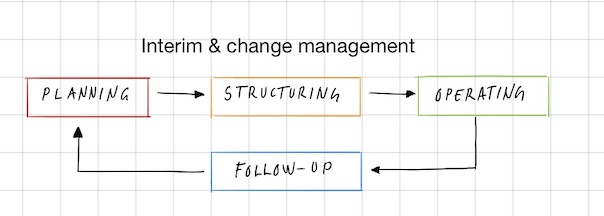Interim management is the novel art of providing leadership capabilities and people insight in order to direct, build and ensure a period of change and transition within an organization”.

…and its done by shaping capacity and peoples’ capabilities to plan, structure, run and measure operational outcome.
Interim and value
The ability to advise, shape and lead change is possible because interims are part of organisation and their advice is perceived to be honest as interims operate independently of the organisation’s past and future politics. Therefore interim managers are typically brought in to implement change or support an organisation to grow out challenging periods of times.
Interim and capabilities
Interim leaders bring valuable insights and experience to organizations undergoing challenges. They can step into key managerial roles during times of transition and strengthen internal capabilities through their expertise. Moreover, they can fill key managerial roles for a defined period. Characteristic for interim leaders are:
- Highly qualified and brings broad leadership capabilities obtained from different industrial environments. Normally, they also bring deep experience from some business disciple.
- They bring know-how and skills to make rigorous assessments of the organisation’s current situation and future needs.
- Have the ability to structure and shape plans that engage people and they are confident in drive implementation programs.
- Ability with short notice act as a line managers taking responsibility for sustain and developing organisation and people.
People and Change
Since all aspects of interim and change journeys involve people, interim leaders ought be able to balance various organizational needs while implementing solutions to achieve objectives. They also need to make sound judgments when weighing short-term priorities against long-term goals. Ultimately, an effective interim leader should be able to frame change and communicate transition in a way that inspires and motivates people.
From – To
In any change journey, it’s crucial to explain the ’why’ within a clear context. Therefore, interim leaders must effectively manage and communicate the rationale behind the change. This includes describing the transition and objectives in simple, ‘from–to’ terms, while also coaching and empowering colleagues to actively contribute toward the organization’s goals. Successful change depends on collaboration and trust, which must be embedded within teams. To support this, it’s essential to create an environment of shared consciousness about where the organization is headed—and why.”
Operations and implementations
As the implementation of new operations becomes established. The interim leader shift focus to sustaining operations and plan for a semless hand-over to the permanent leadership. – A well-structured hand-over process is important both for the organisation, as well as for the interim leader – since both their futures is based on a successful track record.
Deliveries and feedback
At the end of an interim mission, the Interim leader ought to reflect on what the organisation have achieved in the light of the objectives and the organizational development during the assignment. This ”lesson learnt” is normally summarized in an Interim report, that provides additional value for the organisation going forward and normally includes recommendations for the permanent leadership based on experience of the misson.
Example of interim solutions can be found via this link: Interim Services
Certified Change Practitioner leveraging the PROSCI methodology to effectively drive transition and change initiatives.